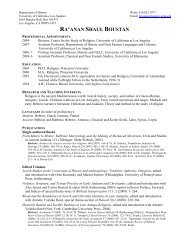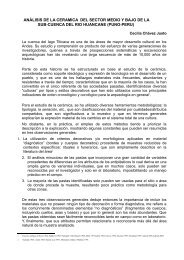The Long-Term Effects of Africa's Slave Trades - Social Sciences ...
The Long-Term Effects of Africa's Slave Trades - Social Sciences ...
The Long-Term Effects of Africa's Slave Trades - Social Sciences ...
You also want an ePaper? Increase the reach of your titles
YUMPU automatically turns print PDFs into web optimized ePapers that Google loves.
slave caravans allows one to produce reasonable estimates <strong>of</strong> the origins <strong>of</strong><br />
slaves shipped. A full description <strong>of</strong> the data and the construction <strong>of</strong> the<br />
estimates is in Nunn (2006a).<br />
Although the data are more limited for the Red Sea and trans-Saharan<br />
slave trades, I show in Section 7 that the results <strong>of</strong> the paper are driven<br />
by the trans-Atlantic slave trade. None <strong>of</strong> the results reported in the paper<br />
rest on the estimates <strong>of</strong> the slaves exported during the Red Sea and trans-<br />
Saharan slave trades.<br />
To illustrate the procedure that I use to combine the shipping data and<br />
the ethnicity data to construct my estimates, I use an example, which is<br />
shown in Figure 1. <strong>The</strong> figure is a hypothetical map <strong>of</strong> the western coast <strong>of</strong><br />
Africa.<br />
Atlantic<br />
Ocean<br />
AFRICA<br />
↑<br />
N<br />
100,000 ⇐<br />
Country A Country B<br />
250,000 ⇐<br />
Country C<br />
Country D<br />
Country E<br />
Figure 1: An Artificial Map <strong>of</strong> Africa’s West Coast<br />
From the shipping data, I calculate the number <strong>of</strong> slaves shipped from<br />
each coastal country in Africa. In the example, 100,000 slaves are shipped<br />
from Country A and 150,000 are shipped from Country B. <strong>The</strong> problem<br />
with relying on the shipping data alone is that many <strong>of</strong> slaves shipped from<br />
Country A may have come from Country B, which lies landlocked behind<br />
Country A. Using the ethnicity data, I construct the ratio <strong>of</strong> slaves from<br />
each coastal country relative to the landlocked countries to the interior <strong>of</strong><br />
the coastal country. That is, I use the ethnicity data to determine the ratio<br />
<strong>of</strong> slaves from Country A relative to Country B, and from Country C relative<br />
to Countries D and E. Assume that the ratio <strong>of</strong> Countries A to B is 4 to<br />
1, and Countries C to D and E is 3 to 1 to 1. Using the ratios I calculate<br />
15
















